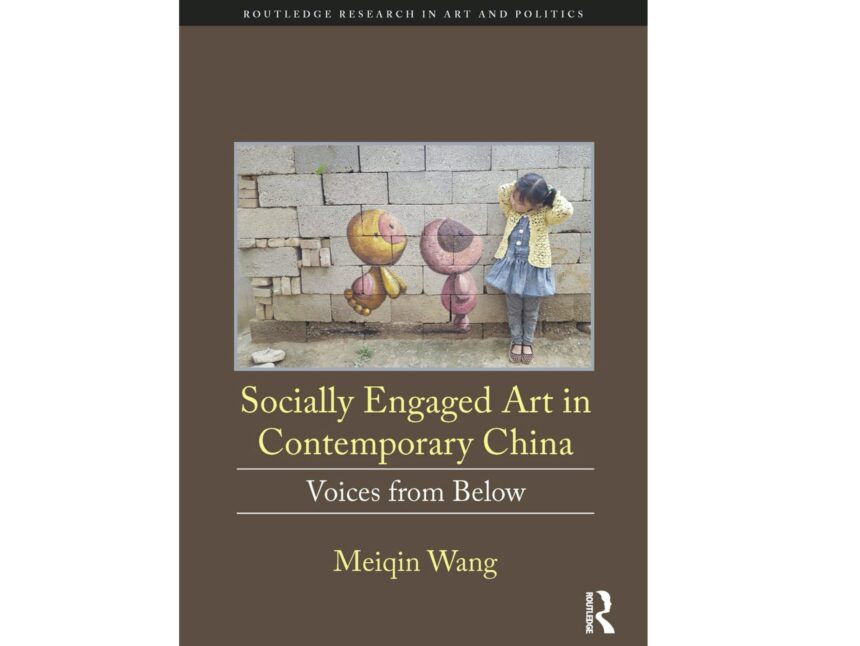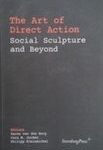Meiqin Wang, Socially Engaged Art in Contemporary China: Voices from Below (New York: Routledge, 2019)
Mai Corlin
In the following, I present a review of Meiqin Wang’s valuable contribution to the research literature on socially engaged art in China along with a somewhat lengthy critique of the methodology used in the book. The critique will be familiar to regular readers of FIELD and is concerned with the way socially engaged art projects are researched. My proposition is that ethnographic fieldwork is necessary in order to understand how these projects forge mutual, reciprocal relationships with local community in a manner that includes the voices of the community—and not only the artists—in our empirical data.
But first the book itself. Meiqin Wang’s well-written book Socially Engaged Art in Contemporary China (2019) presents a broad range of socially engaged art practices in China. Divided into three parts the book places socially engaged art in China within a spectrum ranging from art as social criticism to art as place construction and on to art as personal development. The book covers rural as well as urban projects, photography as social criticism, rural reconstruction through art projects, art education projects and participatory art practices. Furthermore, Wang introduces a Chinese terminology and discourse to help readers understand the unfolding of these projects through the thinking of artist and independent curator Wang Nanming.
Part I
Under the headline of “social criticism,” part I introduces Wang Nanming’s thinking along with close readings of the early photographic practices of artists such as Qu Yan and his “Space of…” series, the conceptual photography of Ni Weihua and Liang Yue and photographer and filmmaker Wang Jiuliang especially well-known for his Beijing Besieged by Waste exhibitions and film. The first chapter outlines a Chinese theoretical landscape of “critical art,” based in the thinking and writing of Wang Nanming and his notion of “Chinese Problem Situation Art.” Meiqin Wang argues that Wang Nanming’s ideas should really be understood as an attempt at theorizing socially engaged art (p. 28). The introduction of a Chinese-based terminology and mode of thinking to understand these practices is immensely important and a valuable part of the book. The chapter comes to serve as the theoretical basis of the book and the lens through which we can understand these new and emerging practices. A whole range of thinking is introduced in tandem with Wang Nanming’s, and as such the chapter is very useful as part of a curriculum on contemporary Chinese art.
However, by devoting the first of three parts to this topic, Wang seems to place social criticism and photographic representation as a sub-category of socially engaged art. Wang writes that part I of the book “perceives critiques instigated by art critics and artists in their professional practices as forms of social engagement that aim to change the perception and consciousness of the public, and thus can be discussed in the framework of socially engaged art” (p. 19). I would argue that the articulation of a narrower definition of socially engaged art is necessary in this case. While these practices are no doubt relevant to the later formation of socially engaged art in China, as precursor to the practices we see today, I still think that to view social critique as social engagement in a book on socially engaged art is problematic as it blurs the boundaries (even more than they already are) for what socially engaged art then is. If we do not try to set some boundaries for what we are talking about, when we talk about socially engaged art, the term becomes fuzzy and meaningless. I think Simon Sheikh states it very clearly in his rereading of Lucy Lippard’s Trojan Horses,[1] when he distinguishes between political commentary and activist art. That is “between social concerns and political commentary on the one hand and between community involvement and organizing on the other.”[2] I argue that the same distinction is relevant in terms of socially engaged art. This would also be in line with Wang’s own understanding of socially engaged art, based on Pablo Helguera’s definition: “What characterizes socially engaged art is its dependence on social intercourse as a factor of its existence” (Helguera quoted in Wang, p. 2).
Part II
While part one of the book deals with art as social criticism, part two deals with art as place construction, more specifically focusing on two art professionals both tapping into the discourse of “creative development,” Zuo Jing, practicing rural reconstruction through art, and Zheng Dazhen working with urban renewal and community building in what Wang terms “lifestyle activism.” Both projects are intimately connected with the local authorities as they are actively invited in and funded by them. As Wang describes the rural reconstruction through art movement that Zuo Jing is representative of: “It is a soft form of social intervention and cultural activism since its practitioners have to collaborate with various levels of governments in one way or another in order to carry out their programs. It therefore involves a lot of cooperation, explanation, and persuasion as well as efforts to bring government officials from different levels in for support or non-intervention in their creative place-making endeavors” (p. 140). The close relationship to the government should raise questions in terms of their possibility for providing social critique, however, Wang refrains from addressing this issue. The relationship to the local government does not make these projects less interesting—I just wish to point out that it is not sufficiently clear what this close relationship entails, and Wang’s book does not offer any clues.
Part III
The third and last part of the book is concerned with “Art and Personal Development,” and presents projects that revolve around “the lifelong learning process that every human being is entitled to” (p. 147) as a form of “individual-based volunteerism” (209). One of the most interesting chapters of the book is found in chapter 6 in this section, entitled “Art Education for Children.” The chapter is concerned with artist Hu Jianqiang’s People’s Kindergarten project and performance artist Wang Jun’s Mentors Academy. People’s Kindergarten was set up in rural Gansu Province and through their Volunteer Project—initiated in collaboration with ZaoSpace—they invite artists and artist groups to come and serve as teachers in the kindergarten for a set period of time. Wang manages to convey the story of the People’s Kindergarten in a manner that gives a vibrant impression of both the success and obstacles there can be when working with small children in a poor rural town. Although we never hear from the surrounding community or the children themselves, we learn that the People’s Kindergarten project takes place in the local community and asks the visiting artists to work directly with local community issues in a manner that engages everyone— children and grownups alike.
Critique of methodology
Moving on to questions of methodology. Wang’s ethnographical data undergirding the research primarily comes from interviews conducted with the initiating artist as well as visits to the project sites. The book is focused on the “art professionals”—as Wang refer to them—as “individuals” (pp. 1 and 12), neglecting the many people, communities, authorities or villagers that get implicated in the process of a socially engaged art project. We rarely hear what members of the community think or what the local authorities think about what is going on and how the projects have developed or changed along the way. Socially engaged art projects are often time-consuming long-term efforts that rarely (if ever) stay the same. If we only rely on the narrative presented at one point in time by the one artist in charge, then we get a skewed picture of the dynamics within the projects.
Furthermore, as Wang herself also notes (p. 5), the practice of socially engaged art can be understood as a departure from representation, thus based in a wish to provide social critique without representing. However, if we as researchers enter these projects and only rely on the voice of one or two artists in our understanding of the projects, then we are complicit in retaining the artist in the position of representative power. As Grant Kester argues, it happens that “In many community-based public art projects it is precisely the community whose voice is never heard. The institutional authority of the artist, their privileged relationship to channels of ‘legitimate’ discourse about the project (through media coverage, their alliance with sponsoring and funding agencies, etc.), conspire to create the appearance of a harmony of interests even where none may actually exist.”[3] It seems clear to me that this is what is happening in Wang’s book—she is furthering the institutional authority of the artist by not proposing other methods to research these types of art practices. By changing the methodology to methods rooted in an ethnographic research practice it would be possible to obtain a more nuanced and in-depth understanding of these projects of socially engaged art that—perhaps!—avoid misrepresentation of a community. Furthermore, using an ethnographic field work approach, we can better answer questions about how the projects change along the way and what kind of methods are constructive in the long run. As Wang argues, time is essential when initiating projects of social change (p. 214).
In the introduction, Wang asserts that the artistic practices she analyzes in the book “constitute a balanced representation of the diversity of complexity of socially engaged art in China” (p. 3). While the selection of artists does give a good and broad idea of how the practice of socially engaged art unfolds in China, I wonder whether it is necessary for the book to claim to be “representational”? The practice of socially engaged art in China is so diverse and constantly changing, and while the selection in the book is relevant and important, it does come across as somewhat skewed. The focus of the book seems to be on projects that “tend to avoid direct confrontation with the state, or even try to work with various local governments in materializing their socially conscious art, cultural, and community projects” (p. 10). However, there are plenty of examples of socially engaged art projects in China that do not maintain a close relationship to local authorities and that propose more collective organizational measures, such as Dinghaiqiao Mutual Aid Society (定海桥互助社), the community space SoengJoengToi (上阳台), the art platform HB Station (黄边站) or the filmmaking collective behind Caochangdi Workstation (草场地工作室) to name a few ongoing projects. By focusing on “art professionals” and “individuals” Wang comes to disregard all the collective practices taking place in China today, though one is mentioned through the People’s Kindergarten project in rural Gansu, where the Nanjing-based art collective Huamao First Floor (HMFF) becomes involved as teachers (p. 194). Nevertheless, in Wang’s book, the mutual relationship to local community that is the focus of so many of these projects is not explored, which feels like a lost opportunity.
Formal issues
In terms of form, the following will only be a problem for Chinese-speaking readers. The bibliography only gives titles of Chinese texts in translation, with no pinyin or characters included. This I think is a mistake, as it makes it very difficult to retrace Wang’s steps as it is practically impossible to figure out which Chinese text Wang is actually referring to. I wonder what the logic behind this decision was. Furthermore, no pinyin or characters of the specific Chinese terms are given within the text of the book, which I can understand as a stylistic choice, but as with the bibliography it makes it difficult to trace the terms Wang is referring to in a Chinese context. Since Wang’s book makes an effort to introduce the English-speaking reader to a Chinese vocabulary of socially engaged art, I think it is a shame we are only provided with the translations.
Nevertheless, Meiqin Wang has written a well-researched book that presents a useful and interesting selection of socially engaged art projects in contemporary China, that have not received much coverage elsewhere. As such, the book is a valuable addition to the literature on contemporary Chinese art in general and the growing field of socially engaged art in particular.
Mai Corlin has a background in Sinology and researches socially engaged art practices in contemporary China and Hong Kong. Part of this research will be presented in her upcoming book The Bishan Commune and the Practice of Socially Engaged Art in Rural China (Palgrave Macmillan, forthcoming). Corlin has a PhD degree in China Studies from Aarhus University, Denmark and is currently a postdoctoral researcher with the Department of Fine Arts at the Chinese University of Hong Kong.
Notes
[1] Lucy Lippard. “Trojan Horses: Activist Art and Power.” In Brian Wallis, ed., Art after Modernism: Rethinking Representation. (New York: The New Museum of Contemporary Art, 1984), pp. 341–357.
[2] Simon Sheikh. “Positively Trojan Horses Revisited.” E-flux Journal, no. 9,10 (2009). URL: http://www.e-flux.com/journal/positively-trojan-horses-revisited/
[3] Grant Kester. “Aesthetic Evangelists.” Afterimage, no. 22, (January, 1995), p. 8.







